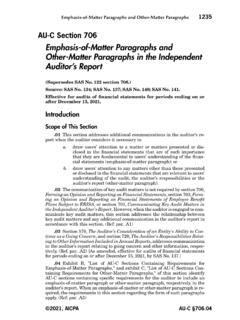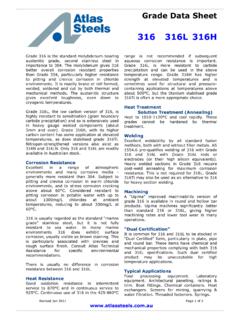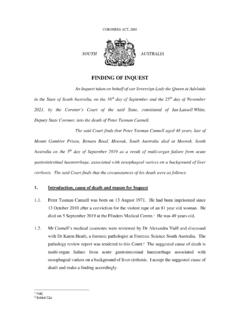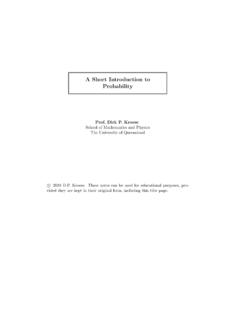Transcription of Chapter 4. Basic Failure Modes and Mechanisms - NASA
1 89 Chapter 4. Basic Failure Modes and MechanismsS. KayaliFailures of electronic devices, in general, can be catastrophic or failures render the device totally nonfunctional, while noncatastrophicfailures result in an electrically operating device that shows parametric degradation andlimited Chapter provides a description of some of the more common Failure modesand Mechanisms affecting GaAs-based MMICs. The current understanding of the topicwill be presented along with a discussion of some possible solutions, practiced processimprovements, and Failure ModesGaAs devices exhibit some general Failure Modes that can be attributed to adefined Failure mechanism. The most common Failure Modes are observed viadegradation of the MMIC parameters such as IDSS, gain, POUT, and others. Thedegradation observed in MMIC devices is normally a function of the material interactionsand the environmental conditions during test or operation.
2 The importance of a particularparameter degradation depends greatly on the design and function of the MMIC and therelationship between the observed degradation and the general health of the device inquestion. A list of the most common Failure Modes is provided in Table 4-1. Life tests,with RF or dc excitation and performed under controlled conditions, are the mostcommon means of Failure -mode detection. These tests can provide valuable informationas to the type of degradation to which the particular device under test may be mostsusceptible, and the severity of the effect on the performance of the 4-1. Common MMIC Failure ModeMethod of DetectionRelated FailureMechanismsPossible SolutionsDegradation in IDSSLife test, operationGate sinking, surfaceeffects, hydrogeneffectsDerating criteria,temperature control,environmental controlDegradation in gateleakage currentLife test, high-temperaturestorage test, high-temperature reverse biasInterdiffusionTemperature control, gatecurrent control, properpassivationDegradation in VPLife test, operationGate sinking,hydrogen effectsTemperature control, useof stable barrier materials,environmental controlIncrease in RDSLife test, operationGate sinking, ohmiccontact degradationTemperature control, useof stable barrier materialsDecrease in POUTLife test, operationSurface effects,hydrogen effects,gate sinkingTemperature control, useof stable barrier materials.
3 Environmental control90 While dc testing is much easier and more cost effective to implement, RF testinghas the advantage of providing the user with direct information in regard to devicedegradation under conditions similar to those of the actual application. Correlationbetween the results of dc tests and actual RF application has been a topic of great interestand debate in the GaAs reliability community, but to date there is little understanding oragreement of the in IDSSThis Failure mode is one of the most common and easiest to detect. Acceleratedlife tests have been used to provide an estimation of the lifetime of devices based on theobserved level of IDSS degradation. Various Failure Mechanisms can be attributed to bethe cause of this observed degradation. One of the most common is referred to as gatesinking.
4 In this mechanism, a reduction in the active channel of the device results in adecrease of IDSS among other parameters. Another common mechanism, which can causesimilar degradation, is referred to as hydrogen poisoning. This mechanism is theorizedto cause a decrease in the donor density in the channel, which in turn causes a reductionin IDSS [1]. A detailed discussion of Failure Mechanisms will be presented in Section in Gate Leakage CurrentThis Failure mode is generally observed in devices subjected to an accelerated lifetest or to high operating temperatures. The degradation is observed as an increase in thegate leakage current over the duration of the test. No experimentally identified failuremechanisms have been linked to this Failure mode, but surface-state effects have in Pinch-Off VoltagePinch-off voltage (Vp) degradation is another common Failure mode for GaAsdevices.
5 This degradation results primarily from metal semiconductor interactions andinstability of gate-metal structures. The degradation is normally observed on devicessubjected to accelerated life tests or high-temperature operation. Reliability relatedeffects of metal semiconductor interactions may render the associated barrier layersineffective due to poor manufacturing practices or material choices. The choice of theappropriate barrier material to limit Au/GaAs interdiffusion is the best method to limitthe effects of this degradation may cause the same observed pinch-off voltagedegradation effects [1]. This degradation is theorized to be caused by either a reductionof carrier concentration in the active channel of the device or a change in the surface statebuilt-in potential. Further information on this degradation is found in Section in Drain-to-Source ResistanceThe increase in the drain to source resistance (RDS) can be attributed to either gatesinking or to ohmic contact degradation.
6 Both of these Failure Mechanisms are metal semiconductor related degradation Mechanisms that are accelerated with , devices subjected to accelerated life tests or operation at elevated temperaturesgenerally exhibit this in RF PerformanceVarious RF parameters can exhibit degradation over the lifetime and operation ofthe devices. Although it is very difficult to extrapolate RF performance from dc test data,some manufacturers use particular dc parameters as predictors of resultant RFperformance. IDSS, for example, can be used as a predictor of saturated powerperformance, while gm can be used for prediction of gain and noise figure degradation insmall-signal and low-noise causes of RF parameter degradation vary, depending on the technology andoperating conditions of the devices under test. In general, surface-state density andresultant surface effects play a role in overall RF device performance and stability overtime.
7 Material interaction effects also play a major role in long-term device factors, such as hydrogen-related degradation and other environmental effects, canalso contribute to the overall MechanismsFailure Mechanisms of electronic semiconductor devices can be divided into thefollowing general categories:(1)Material-interaction-induc ed Mechanisms .(2)Stress-induced Mechanisms .(3)Mechanically induced Failure Mechanisms .(4)Environmentally induced Failure Mechanisms can in turn be subdivided into two generalcategories, the first being semiconductor die material and metal interactions, and thesecond being a result of die packaging and interconnect. Stress-induced failuremechanisms can be directly attributed to either poor device design or poor and carelessdevice application. Environmentally induced Failure Mechanisms can cover a widespectrum of possible environmental conditions, such as humidity and hydrogen device- Failure Mechanisms can be a result of one or a combination ofthese factors.
8 Therefore, care must be exercised in understanding the operating andenvironmental conditions and process variables associated with the reported 4-2 shows the main areas of responsibility for the Failure -mechanism categories. Inthis Chapter , a discussion of the general categories of Failure Mechanisms will beprovided, along with reference examples as Failure MechanismsGaAs processes involve a number of metal semiconductor interfaces which, ifnot designed and applied properly, may cause device degradation and Failure . The twomain metal semiconductor interfaces in GaAs-based devices are the Schottky gatecontact and the ohmic source and drain contacts. The common metallization structuresfor GaAs are based on the industry standard Au/Pt/Ti or Au/Pd/Ti on GaAs. The thermal92 Table 4-2. General responsibilities for the Failure -mechanism Mechanism CategoryManufacturer ControlUser ControlMaterial-interaction induced Stress induced Mechanically induced Environmentally induced stability and reproducibility of Schottky barriers, the correct choice of metals and theirapplicable processing parameters, and the GaAs surface conditions all play a role in thereliability of the produced structures and the applicable Failure Mechanisms .
9 Failuresrelated to Schottky and ohmic contacts occur when the metals diffuse into thesemiconductor, and the Ga and/or As diffuse into the contact. A description of the failuremechanisms related to these interfaces will be provided along with relevant SinkingThe performance of GaAs-based devices relies heavily on the quality of the activechannel area of the device. The Schottky gate metal-to-semiconductor interface directlyinfluences the device electrical parameters, such as the drain saturation current andreverse breakdown. The gate structures are based on the industry standard mutilayerAu/Pt/Ti or Au/Pd/Ti on GaAs. Interdiffusion of gate metal with GaAs results in areduction of the active channel depth and a change in the effective channel doping. Thiseffect is termed as gate sinking. This process is affected by the surface conditions ofthe GaAs material at the time of deposition, the deposition parameters, and the choice ofdeposited Failure mechanism is generally observed after exposure to an accelerated lifetest or operation at elevated temperatures, the driving factor for this mechanism being thethermally accelerated diffusion of Au into GaAs.
10 The common gate metallizationstructure consists of three layers. The first layer contacting GaAs is a thin Ti layer usedprimarily for adhesion. The second layer is either Pd or Pt. This layer is used as a barrierto Au diffusion into GaAs. The last layer is thick Au used for conduction. The rate ofAu gate-metal diffusion into the GaAs is a function of the gate-metal material diffusivity,the temperature , and the material-concentration gradient. For perfect lattice structures,the diffusion rate at normal operating temperatures is too slow to have an effect on deviceperformance. However, when large grain boundaries or large numbers of surface defectsexist, the diffusion rate can be fast [2].Au has a high diffusion factor into GaAs, therefore a Pt or Pd layer is employed toact as a barrier to Au diffusion into GaAs.









